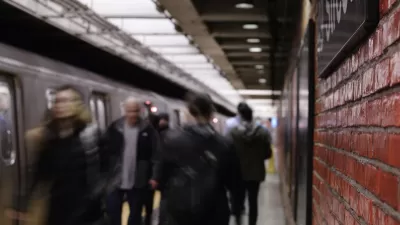After a shocking death and an overall rise in violent crime at its stations, New York City's transit authority will install platform barriers to prevent intentional or accidental falls onto tracks.

The New York MTA will test platform barriers at three of its stations. As Michael Gold and Ana Ley report, the move comes after one woman was pushed in front of a train at the Times Square station, which safety advocates argue could be avoided by installing the glass doors present in many other subway systems around the world. "The announcement comes as many New Yorkers have become anxious about safety on the subway, where the rates of violent crime per million weekday passengers have risen during the pandemic even as ridership has plunged, and where the number of people who end up on the tracks, most of them intentionally, is rising."
The barriers, also called platform edge doors or platform screen doors, block riders from accessing the tracks until a train has arrived. While the MTA has insisted that installing them in all of New York's subway stations isn't feasible due to "special complexities" and cost, the recent death of Michelle Alyssa Go, the woman who was pushed off a platform, prompted the agency to take up the issue once more. "Still, expanding the pilot would present significant financial and logistical challenges. The price tag for installing barriers at the 128 stations would be about $7 billion, according to the 2019 report [released by the MTA]."
In addition to the doors, the agency says it is exploring additional options for safety improvements that include cameras at the front of trains, increased police presence on platforms, thermal detection systems, and public service announcements that address mental health and warn riders away from the tracks.
FULL STORY: Subway Platform Barriers Will Be Tested at 3 N.Y.C. Stations

Study: Maui’s Plan to Convert Vacation Rentals to Long-Term Housing Could Cause Nearly $1 Billion Economic Loss
The plan would reduce visitor accommodation by 25,% resulting in 1,900 jobs lost.

North Texas Transit Leaders Tout Benefits of TOD for Growing Region
At a summit focused on transit-oriented development, policymakers discussed how North Texas’ expanded light rail system can serve as a tool for economic growth.

Using Old Oil and Gas Wells for Green Energy Storage
Penn State researchers have found that repurposing abandoned oil and gas wells for geothermal-assisted compressed-air energy storage can boost efficiency, reduce environmental risks, and support clean energy and job transitions.

Santa Barbara Could Build Housing on County Land
County supervisors moved forward a proposal to build workforce housing on two county-owned parcels.

San Mateo Formally Opposes Freeway Project
The city council will send a letter to Caltrans urging the agency to reconsider a plan to expand the 101 through the city of San Mateo.

A Bronx Community Fights to Have its Voice Heard
After organizing and giving input for decades, the community around the Kingsbridge Armory might actually see it redeveloped — and they want to continue to have a say in how it goes.
Urban Design for Planners 1: Software Tools
This six-course series explores essential urban design concepts using open source software and equips planners with the tools they need to participate fully in the urban design process.
Planning for Universal Design
Learn the tools for implementing Universal Design in planning regulations.
Ascent Environmental
Borough of Carlisle
Institute for Housing and Urban Development Studies (IHS)
City of Grandview
Harvard GSD Executive Education
Toledo-Lucas County Plan Commissions
Salt Lake City
NYU Wagner Graduate School of Public Service





























